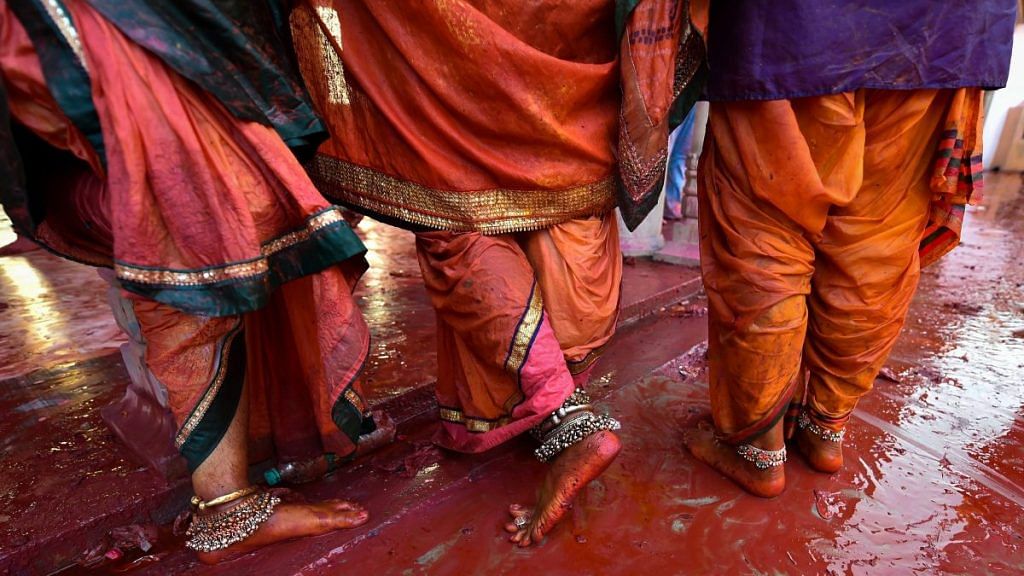Just how inclusive is the festive space of Holi? Clearly, not much, if an ad about a detergent leads to speculations about ‘love jihad’, and a movement to ban the product. But rewind back to historical archives and we might find that Holi was not very harmonious to begin with. Men have been killed, women raped, and villages burnt and razed all because of Holi festivities.
15th century: Purity and pollution
The most prevalent and noticeable exclusionary social practice has been to physically bar a group from the space of festivities. That is where the paradigm of purity-pollution comes into play.
There is a reference to such exclusionary practices in the 15th-century text Virupaksha Vasantotsava Campu. Composed in erstwhile Vijayanagara, the text contains an account of the Rathotsava that took place during the Vasanta Utsava surrounding Siva and Parvati that would take place as a celebration of spring. Leona May Anderson, who has worked on the subject, talks about how the Turia varna (that she translates as shudras) were prohibited from the celebrations. The text mentions the people from this caste taking recourse to tall buildings outside the city and trees to watch the festivities.
Later in the text, when one does find a reference of shudras participating in the festivities, it is to draw the chariot (along with others) of a wealthy merchant. Eventually, their chariot ends up in a competition with one drawn by the Brahmins. And, the Brahmins, both Saivite and Vaishnavite, set aside their sectarian differences to verbally assault and attack the ‘enemy of Siva’ – the shudras. It is interesting to note how unity between two conflicting sects came about because an excluded group attempted to enter the festive space. The inter-caste divisions were maintained to preserve the privilege to celebrate and to partake in festivities.
Also read: Move over Bhang, the new Holi vice at farmhouse parties is Ecstasy
18th Century: Violence and spectacle
Social historian of pre-colonial South Asia Elizabeth Thelen has studied how Holi became a site of contestation and conflict in northwest India in the 18th century. She cites an incident, which took place between two wealthy merchant communities in Rajasthan’s Nagaur in 1764. The trouble started when the Agarwals (primarily Hindu) intruded into the Khandelwal’s (primarily Jain) gehar or Holi procession. The conflict escalated to a point that the issue was brought to the notice of the Marwar court.
In 1767, another such instance occurred when a Holi procession made up of Hindu Mahesri merchants harassed Jain ascetics.
While festive excesses discussed occur at the expense of exploitation of a visible minority, such transgressions are more likely to go unnoticed as the difference in status and power is not as visible.
Also read: Don’t tell women sexual harassment hurts Hindu pride, tell hooligans to leave Holi alone
Early 20th century: Exploitation and excess
Exploitation can also occur without any intrusion into the festive space. For instance, The Leader reported a case in 1916, wherein a man named Khima who was “a metal worker by caste” was attacked by upper castes who were part of a Holi procession. Khima had recently undergone Arya Samaj’s suddhi ceremony along with his two brothers and was wearing “sacred threads”. Coming to know of this, members of the procession decided to make him surrender his sacred threads and ransacked the houses. In this case, the dominant social group used the festive space to mete out punishment to men who tried to acquire upward social mobility.
Another report in The Times of India in 1938 demonstrates how a festive space is structured around the exploitation of an already marginalised group. It reported in March of a custom in Malwa known as Jabra wherein an earthen pot “containing ashes, chillies and water” was smashed on the head of a “Balai woman on Holi day” who was later paraded around the village. Although this custom was later stopped to “protect the Harijans if they were tyrannized”, there are many other instances of festive excess that took place (or still do) at the expense of exploitation.
Also read: TalkPoint: Has Holi become a festival of fear for women?
‘Bura na mano Holi hai’
In popular imagination, Holi has still successfully retained its status as a festival of harmony and joy.
But it was only as recent as 2017 when the Dalits of Uttar Pradesh’s Rudayan village began playing Holi again. They had stopped playing after 1990 when a Dalit man dared to apply colour on an upper caste villager, leading to his death and the razing of houses of 42 Dalit families.
And it was not long ago when Lalasa Devi (chamar by caste) was raped by an upper-caste Rajput man. Prachi Patil who has worked on the intersectionality of gender and caste violence, has noted how the man was a part of a Holi procession and called her by her caste name before raping her. The incident took place in 2013 in UP’s Dalan Chapra village.
Such instances are often treated as ‘stray references’ or with angry denial. Although Dalit scholars and activists have already written on how Holi, much like many dominant upper caste festivals, is an occasion to repress and exploit both the bodies and the labour of underprivileged castes, it has barely scratched the surface. However, for now, the simplest gesture towards a more inclusive Holi that anyone can easily partake in is to consider before they carry on their customs and ‘fun’, and whether it comes at the expense of another.
The authors are graduate students of history and art history at Mcgill University and University of Wisconsin Madison.
